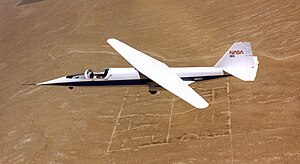NASA AD-1
| AD-1 | |
|---|---|
 |
|
| The AD-1 with its wing at a moderate angle | |
| Role | Experimental aircraft |
| National origin | United States |
| Designer | Burt Rutan |
| Built by | Ames Industrial Co. |
| First flight | 21 December 1979 |
| Retired | August 1982 |
| Primary user | NASA |
| Number built | 1 |
| Unit cost |
USD $240,000
|
The NASA AD-1 was both an aircraft and an associated flight test program conducted between 1979 and 1982 at the NASA Dryden Flight Research Center, Edwards California, which successfully demonstrated an aircraft wing that could be pivoted obliquely from zero to 60 degrees during flight.
The unique oblique wing was demonstrated on a small, subsonic jet-powered research aircraft called the AD-1 (Ames-Dryden-1). The aircraft was flown 79 times during the research program, which evaluated the basic pivot-wing concept and gathered information on handling qualities and aerodynamics at various speeds and degrees of pivot.
The first known oblique wing design was the Blohm & Voss P.202, proposed by Richard Vogt in 1942.
The oblique wing concept was later promoted by Robert T. Jones, an aeronautical engineer at NASA's Ames Research Center, Moffett Field, California.
Analytical and wind tunnel studies Jones initiated at Ames indicated that a transport-size oblique-wing aircraft, flying at speeds up to Mach 1.4 (1.4 times the speed of sound), would have substantially better aerodynamic performance than aircraft with more conventional wings.
At high speeds, both subsonic and supersonic, the wing would be pivoted at up to 60 degrees to the aircraft's fuselage for better high-speed performance. The studies showed these angles would decrease aerodynamic drag, permitting increased speed and longer range with the same fuel expenditure.
At lower speeds, during takeoffs and landings, the wing would be perpendicular to the fuselage like a conventional wing to provide maximum lift and control qualities. As the aircraft gained speed, the wing would be pivoted to increase the oblique angle, thereby reducing the drag and decreasing fuel consumption. The wing could only be swept in one direction, with the right wingtip moving forward.
...
Wikipedia
